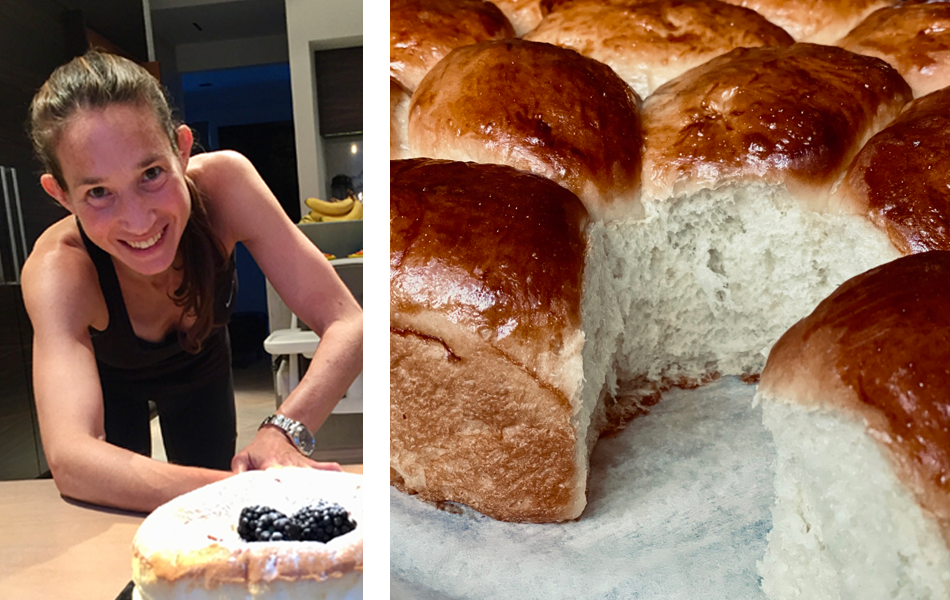December 14, 2021

This Japanese Milk Bread was meant for last week’s blog but my household ate half of it before I managed to get the photos. There are two versions; the rolls and a loaf that makes for amazing toast too.
It uses the tangzhong method which has its origins in Japan's yudane, also known as water roux. This technique was popularized across Asia by Chinese cookery author Yvonne Chen in her book, The 65° Bread Doctor. A portion of the flour is cooked in the water or milk at 65°C, causing the starch to gelatinize. This is then added to the remaining ingredients, resulting in soft, fluffy bread.

Ingredients:
For the tangzhong:
25g white bread flour
6 tbsp water
For the loaf:
300g white bread flour
120ml milk (tepid)
40g caster sugar
30g unsalted butter (melted)
7g easy bake yeast
1 egg
1 tsp salt
Eggwash:
1 egg
Method:
For the tangzhong: Place the flour and water in a saucepan, mix it until it is smooth and lump free. Then heat it on low stirring continuously until it thickens, (will only take a minute or so). Leave to cool.
For the loaf: Add all the loaf ingredients except the egg into a large bowl (keeping the salt and yeast away from each other). Mix the egg into the cooled tangzhong and then add this to the loaf ingredients. Mix everything together and then place dough on a lightly floured work surface and knead for about 5 mins, (you may need to add a little more flour if it is very sticky).
Grease the mixing bowl and place the bread back in it. Lightly oil a piece of cling film and place this over the bowl. Put the bowl in a warm dark place and leave to rise for about an hour and a half (until doubled in size). Grease a 9”x 5” loaf tin.
 Once the dough has risen, on a work surface knock back the dough, (knead for 1 minute) and then divide into 3 equal amounts. Roll out each third into a square, then fold one corner over another. Roll one unfolded corner in towards the other end. Place this seam down into the prepared tin. Do the same with the 2 other pieces, and place them all side by side in the tin. Cover the tin with oiled cling film and leave again in a warm dark place to prove.
Once the dough has risen, on a work surface knock back the dough, (knead for 1 minute) and then divide into 3 equal amounts. Roll out each third into a square, then fold one corner over another. Roll one unfolded corner in towards the other end. Place this seam down into the prepared tin. Do the same with the 2 other pieces, and place them all side by side in the tin. Cover the tin with oiled cling film and leave again in a warm dark place to prove.
Preheat oven to 170⁰C (fan)
Once proved, (the dough should be nearly at the top of the tin) use the remaining egg to wash over the top of the dough and place in the oven for appx 30 mins. The bread will be golden brown and hard to the touch once ready). Allow to cool in the tin on a wire rack for a few mins before turning out and allowing to fully cool.
 For the rolls: Make the dough in the same way. After it has proved for the first time, split the dough into 10 or 11 equal amounts. Grease a 22cm round cake tin and roll each piece into a ball. Place them equidistance from each other, (as they prove they will rise/expand into each other). Cover and leave to prove again. Egg-wash as above but reduce baking time to appx 22-25 mins.
For the rolls: Make the dough in the same way. After it has proved for the first time, split the dough into 10 or 11 equal amounts. Grease a 22cm round cake tin and roll each piece into a ball. Place them equidistance from each other, (as they prove they will rise/expand into each other). Cover and leave to prove again. Egg-wash as above but reduce baking time to appx 22-25 mins.


Gaby Van Clarke
March 24, 2023
March 20, 2023
March 20, 2023
How many Bobs have you got?
These quick clunky haircuts are becoming prolific as hairdressers become less and less able to layer hair properly. Emily had the very common 3-step Bob. The baseline, a step four inches off the bottom, and a sort of torn irregular piece suggestive of a long

Exclusive Offers Every Month
Sign up to our newsletter to receive 15% off your first order.